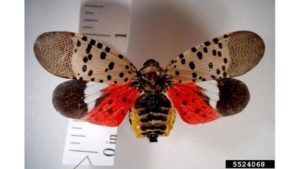
DEC and DAM Announce Statewide Spotted Lanternfly Outreach Campaign
State Agencies Encourage the Public to Report Findings of Invasive Pest
The New York State Departments of Environmental Conservation (DEC) and Agriculture and Markets (DAM) today announced the start of an outreach campaign encouraging New Yorkers to look for and report sightings of the spotted lanternfly (SLF), a new invasive threat. SLF was first found in Pennsylvania in 2014, and efforts to detect the invasive pest have increased after a single, dead SLF adult was found in New York in the fall of 2017.
“DEC and our partners at the Department of Agriculture and Markets are closely tracking the spotted lanternfly, a destructive invasive pest, as part of our ongoing efforts to prevent its establishment and spread in New York. This pest has the potential to severely impact our forests, as well as our state’s agricultural and tourism industries,” DEC Commissioner Basil Seggos said. “New Yorkers are our eyes on the ground and engaging the public’s participation to support our efforts is a crucial step in preventing the spotted lanternfly from establishing itself in our state.”
State Agriculture Commissioner Richard A. Ball said, “With springtime fully underway now, we are encouraging New Yorkers to remain vigilant and help us keep a watchful eye out for the spotted lanternfly. If detected and left unchecked, this invasive species can cause major damage to some of the State’s largest and economically important crops, such as apples, grapes and hops. Working together with our partners at DEC, Parks, and the USDA, the Department will be ramping up its inspections and surveillance, and we are hopeful that additional awareness from the public will help us protect against the establishment of this harmful pest.”
SLF is an invasive pest from Asia that feeds on more than 70 plant species including tree-of-heaven (Ailanthus altissima), maples, apple trees, grapevine, and hops. SLF feedings can stress plants, making them vulnerable to disease and attacks from other insects. SLF also excretes large amounts of sticky “honeydew,” which attracts sooty molds that interfere with plant photosynthesis, negatively affecting the growth and fruit yield of plants.
Although native insects also secrete honeydew, the size of the SLF and the populations of this pest that congregate in an area result in large accumulations of honeydew. The sticky mess and the swarms of insects it attracts can significantly hinder outdoor activities. In Pennsylvania, where SLF populations are the densest, people can’t go outside without getting honeydew on their hair, clothes, and other belongings.
SLF nymphs, or young insects, are black with white spots and turn red before transitioning into adults. Adults, which resemble moths, begin to appear in July and are approximately one-inch long and half an inch wide at rest, with eye-catching wings. Signs of an SLF infestation include:
- Sap oozing or weeping from tiny open wounds on tree trunks, which appear wet and give off fermented odors;
- One-inch long egg masses that are brownish-gray, waxy and mud-like when new. Old egg masses are brown and scaly; and
- Massive honeydew build-up under plants, sometimes with black sooty mold.
While the insect can jump and fly short distances, these pests spread primarily through human activity. SLF lay their eggs on surfaces including vehicles, stone, rusty metal, outdoor furniture, and firewood. When these items are moved, the insects can hitch rides to new areas and therefore be easily transported into New York.
DEC and DAM encourage the public to be on the lookout for and report this pest. Please send pictures and note the location of where the insect, egg masses, and/or infestation signs were found, to spottedlanternfly@dec.ny.gov. Inspect outdoor items such as vehicles and firewood for egg masses. If visiting Pennsylvania or other states with SLF, check equipment and gear before leaving and scrape off any egg masses.
DEC, DAM, and the U.S. Department of Agriculture are working together to address SLF. Since it is less expensive and easier to deal with a pest before it becomes widespread, the goal is to find SLF early or prevent it from entering New York altogether. Extensive trapping surveys will be conducted in high risk areas throughout the state as well as inspections of nursery stock, stone shipments, commercial transports, from Pennsylvania.
“USDA is providing Farm Bill Section 10007 funding to support SLF surveys in New York and ensure early detection and rapid response,” said Kevin Shea, Administrator of USDA’s Animal and Plant Health Inspection Service. “USDA has a strong partnership with New York’s DEC and DAM, and our cooperative SLF efforts are essential to prevent the spread of this destructive plant pest and protect New York’s rich agricultural resources.”
State Parks Commissioner Rose Harvey said, “Spotted Lanternfly poses a significant threat to not only the natural community in New York State Parks but also to the quality of recreational opportunities and experiences we offer. State Parks has been actively engaged with DEC and DAM in planning efforts for surveillance of Spotted Lanternfly, as well as and outreach and education. Our patrons are the first line of defense in identifying and reporting this destructive pest, and we urge them to become familiar with its signs.”
For more information on SLF, visit DEC’s Spotted Lanternfly webpage.

